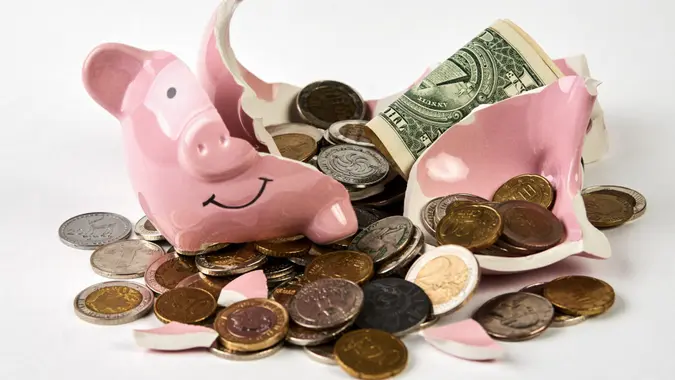Just 25% of Americans Use Digital Wallets — Here Are 4 Popular Options

Commitment to Our Readers
GOBankingRates' editorial team is committed to bringing you unbiased reviews and information. We use data-driven methodologies to evaluate financial products and services - our reviews and ratings are not influenced by advertisers. You can read more about our editorial guidelines and our products and services review methodology.

20 Years
Helping You Live Richer

Reviewed
by Experts

Trusted by
Millions of Readers
Why carry around your money in a wallet when you can pay with the tap of your phone? Digital wallets have made cashless payments much easier and a variety of these apps, also called mobile wallets, have been adopted globally. However, according to research by Ubuy, the United States lags behind many countries when it comes to adopting this new way to pay.
Let’s dive into Americans’ usage statistics, discuss the most popular digital wallets and cover how to use a digital wallet safely.
What Is a Digital Wallet?
A digital wallet is an app or software that securely stores your payment information. With a digital wallet, you can make purchases online or in stores without needing cash or presenting physical cards. These wallets allow you to save credit and debit card numbers, loyalty cards, bank account information and even IDs, all on your smartphone or other devices. Digital wallets make paying at a store as simple as the tap of your phone and often provide extra security features like encryption and fingerprint or facial recognition to keep your money secure.
Digital Wallet Usage by the Numbers
Only about 25% of Americans use digital wallets for in-person shopping, which puts the U.S. in 40th place globally. Around the world, Kenya is the country with the most users of this technology, with 80% of people using mobile wallets for shopping in stores. China and Thailand are not far behind, with digital wallet usage at 72% and 65% respectively, according to the same Ubuy research. By 2025, mobile wallet transactions in North America are projected grow to over $1 billion. To jump on the digital wallet trend, check out these popular digital wallets in the U.S.
Popular Digital Wallets in the US
In the U.S., several digital wallets have emerged as frontrunners. Among the most popular are:
- Apple Pay is seamlessly integrated with Apple devices to allow contactless payments. It is the most widely accepted digital wallet, available in 45 countries and accepted by over 85% of U.S. retailers, according to its website.
- Google Pay is available in most places that accept Apple Pay and is a simple way to make tap-to-pay purchases in stores and save store loyalty card information. In addition to being a great digital wallet for Android phone users, it is a payment processor on over 1.5 million websites which makes online purchases quick and easy.
- PayPal is a staple for both online purchases and peer-to-peer payments and is accepted by 15 million merchants and used in 200 countries for transactions in 25 different currencies, according to its website.
- Cash App is a popular peer-to-peer payment app, Oberlo shared eMarketer data showing that over 50 million users in the U.S. use Cash App. You can connect it to your bank for quick and easy payments to friends, family and businesses.
Keeping Your Digital Wallet Secure
Many people worry about using digital wallets because they fear their personal information might be stolen or misused. However, digital wallets are generally safe to use since they use strong security measures like encryption to protect your data. This means that your payment details are kept private and secure during transactions. While there are risks, following these simple safety tips can help you use digital wallets with confidence.
- Lock your device: Always use a password, fingerprint or facial recognition to lock your smartphone and your digital wallet. This prevents others from accessing your accounts if your phone is lost or stolen.
- Use trusted networks: Avoid making payments over public Wi-Fi. If you must use a public network, make sure the website starts with “https,” which means it’s secure.
- Enable notifications: Turn on alerts for your digital wallet app, so you can quickly spot any unauthorized transactions.
- Keep your apps updated: Set your digital wallet app to automatically update. Updates often fix bugs, address vulnerabilities and upgrade security features, so you always want the latest version.
- Be cautious with links: Don’t click on suspicious links or emails that ask for your wallet information. Always go directly to the app or website you want to purchase from so you know you are putting your information into a trusted source.
More From GOBankingRates
- Nearly 1 in 3 Americans Hit by a Costly Holiday Scam, Norton Survey Shows -- How To Avoid This
- Here's What the Average Social Security Payment Will Be in Winter 2025
- How Middle-Class Earners Are Quietly Becoming Millionaires -- and How You Can, Too
- The Easiest Way to Score $250 for Things You Already Do
 Written by
Written by  Edited by
Edited by 
























